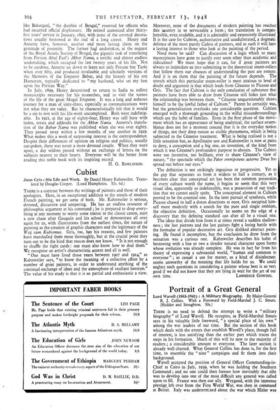Cubist
Juan Grin: His Life and Work. By Daniel Henry Kahnweiler. Trans- lated by Douglas Cooper. (Lund Humphries. 52s. 6d.)
THERE is a contrast between the writings of painters and those of their apologists. Here, in an exceptional addition to the annals of modern French painting, we get some of both. Mr. Kahnweiler is serious, devoted, discursive and unsparing. He has an endless resource of philosophic argument at his command ; he is prepared to drop every- thing at any moment to worry some traitor to the classic canon, start a new chase after Gauguin and his school or demonstrate all over again for us, with illustrations from the earliest times, the nature of painting as the creation of graphic characters and the legitimacy of the Weg zum Kubismus. Gris, too, has his reasons, and few painters have marshalled them more thoroughly, but at the crucial point they turn out to be the kind that reason does not know. "It is not enough to shuffle the right cards : one must also know how to deal them." We recognise an artist's characteristic accent and all is well.
"One must have lived those years between 1937 and 1914," as Kahnweiler says, "to know the meaning of a collective effort by a number of great painters, in order to understand anything of the continual exchange of ideas and the atmosphere of exultant heroism." The value of his study is that it is so partial and enthusiastic a view.
Moreover, none of the documents of modern painting has reached this country in so serviceable a form ; the translation is compre- hensible, even readable, and it is admirably and extensively illustrated It is the case for Cubism, authoritative and unadulterated, a dogmatic defence of the most purely Cubist of painters, and as such it will haw a lasting interest to those who look at the painting of the period.
Need more be said? Can discussion of a logic which so many masterpieces have gone to justify ever seem other than academic and ridiculous? We must hope that it can, for if great painters are always to intimidate us into submitting to the theoretical steam-rollers that follow them our chances of understanding the past are remote. And it is on them that the painting of the future depends. The stretch which this particular steam-roller is most anxious to level of doubt and argument is that which leads from Cezanne to Picasso and Gris. The fact that Cubism is the only conclusion of substance that painters have been able to draw from Cezanne still hides just what the relationship was between them. "Cezanne unquestionably shows himself to be the lawful father of Cubism." Parent he certainly was, but the generalisation overlooks one considerable question. Cubism emerged with a thorough grounding in the wilful misunderstandings which are the habit of families. Even in the first phase of the move- ment which has an appearance of being analytical, the surface,resem- blance does not for a moment conceal that it is the everyday notion of things, not their deep nature as visible phenomena, which is being subjected to the Cezanne treatment. What is being realised is not a little sensation but, as Apollinaire saw and Kahnweiler is now at pains to deny, a conception and a big one, an invention, of the kind from which it was Cezanne's profoundest purpose to abstain. The Cubists were too inventive, too brilliant, ever to share C.ezanne's view of nature, "the spectacle which the Pater omnipotens aeterne Deus has spread out before our eyes."
The definition is not strikingly ingenious or progressive. Yet as the gap that separates us from it widens to half a century, as it becomes clear that conceptual art has been the common possession of every culture worth the name, it begins to seem that this very visual idea, apparently so indefensible, was a possession of our tradi- tion that we cannot easily spare. The conceptual element in Cubism proved to be the essential one. In the later pursuit of synthesis, while Picasso chased in half a dozen directions at once, Gris occupied him- self more modestly with a search for the pure and single emblem, the objective definition. Occasionally he seems on the edge of a discovery that the defining standard can after all be a visual one.
The ideas that divide him from it at times reveal a sudden shallow- ness; the last pierrots and the last guitars fight a losing battle with the formulae of popular decorative art. Gris disliked abstract paint- ing. He found it incomplete, but the conclusion he drew from the sensation was a curious one. Kahnweiler describes his habit of bestowing with a line or two a slender natural character upon forms whose evolution was already complete. He was in fact far from his theory of expressing a substantial world, "human and common to everyone " ; so casual a use for matter, as a kind of disinfectant. seems unworthy of the meaning that life holds for us. We could neglect such questions in considering a painter whose best is so very good if we did not know that they are lying in wait for the art of ow


































 Previous page
Previous page